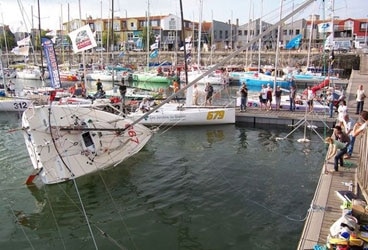
FBSailTrim368
I’m sitting dockside at the Bassin Des Chalutiers in La Rochelle, France, looking out at a harbor full of Mini 6.5s gathered for the 2007 Mini Transat. It’s exciting to be here working with Team Acadia and Clay Burkhalter– the lone American amongst 84 entrants– and the scene around me inspires daydreams of someday participating as a skipper myself. When the race starts on Sunday, competitors from 16 nations will hit the line for this 4,240-mile solo trek to Salvador de Bahia, Brazil. To qualify, each skipper and boat must demonstrate more than 2,000 miles of offshore experience, including 1,000 miles in an offshore race and 1,000 miles in training. The Transat is a true solo challenge; skippers are allowed no outside assistance (except for medical) and no high-tech navigation equipment (except for GPS and an electronic anemometers). Safety checks have already begun, and from the frenzy I’ve witnessed here in La Rochelle, I can say that the pre-start preparations are a race in themselves.As a stepping stone to longer, more expensive races, the Transat has launched some of sailing’s top solo skippers, including Ellen Mc Arthur, Isabelle Autissier, and Sebastien Josse. A few of the talented sailors racing fast, well-prepared boats in this year’s event are Isabelle Joschke (France), Peter Laureyssens (Belgium), and Alex Pella (Spain).Competitors race in two divisions, the more experimental “Proto” class and the more affordable “Series” class, but no matter the class, light and fast is the name of the game. PBO rigging and carbon fiber are everywhere, of course, and I’ve seen some impressive use of composite materials. The French boat Heol Composites has boomerang spreaders to increase headsail area. The mast is simply beautiful, and I look forward to seeing how the boat fares in the race. Competitors are using Spectra line to lash almost everything. Top boats have virtually no shackles; blocks and turnbuckles are all lashed on with Spectra, even in the upper tiers of the rig. Tuning a lashed-on rig is a bear, and skippers are thankful only to have to do it once…hopefully. For mainsheets, travelers, spinnaker sheets, and halyards, competitors are using Karver blocks, which are strong, light, and low-profile.There is no minimum weight limit for the boat or skipper (although there is a significant amount of required safety gear), so methods of keeping things light have been inventive. I’ve heard of skippers removing decals and stickers from everything in their inventory, tearing unnecessary pages out of navigation books, replacing everything metalic with carbon fiber, using solar panels instead of heavier fuel cells (risky business if it gets cloudy), and cutting back on food supplies. Money is the limiting factor in many weight-saving campaigns. Instead of buying lightweight materials, some skippers are leaving behind toothbrushes and sleeping bags. If I were going to sea for 30 days, I wouldn’t leave shore without my iPod and Jetboil stove— gotta have a cup of Joe on the night watch!To read Jennifer Langille’s Sailing World blog, click here.









